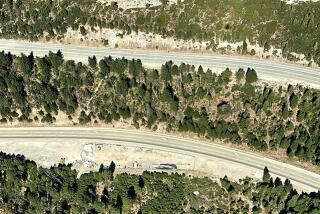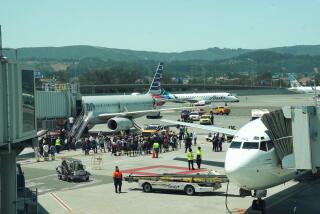Another Japan Airlines Boeing 787 Dreamliner encounters a problem
- Share via
Another Boeing 787 Dreamliner operated by Japan Airlines encountered a problem at Boston’s Logan International Airport, just one day after a fire erupted on a different Dreamliner parked at a gate.
About 12:25 p.m. EST Tuesday, a Japan Airlines Dreamliner headed to Tokyo was taxiing to the runway for takeoff when a fuel leak forced it to return to the terminal.
Japan Airlines, or JAL, did not immediately provide any information on the incident. A person on the scene said the leak dumped about 40 gallons of fuel on the taxiway.
“Facilities personnel responded to clean the area,” said airport spokesman Richard Walsh, who could not confirm the quantity of fuel leaked.
Boeing Co. spokeswoman Julie O’Donnell said, “We are aware of the incident and are working with our customer.”
2012 Quiz: The year in business
The news pushed the Chicago company’s stock lower Tuesday. Boeing shares fell $2, or 2.6%, to $74.13 after dropping 2% on Monday.
The plane was the first JAL jet to attempt to return to Tokyo since another JAL Dreamliner caught fire Monday, not long after landing at Logan. The fire broke out less than a half-hour after 183 passengers and crew members had disembarked from a 12-hour transpacific flight from Tokyo. A maintenance crew mechanic noticed smoke in the cabin.
The cause of the fire is being investigated by Boeing and the National Transportation Safety Board. The NTSB on Tuesday said it found “severe fire damage” in a rack of lithium-ion batteries in the jet’s electronics bay.
Using high-capacity lithium-ion batteries is part of Boeing’s new design for the 787’s electrical system, which consumes more power than other jets.
The identification of the lithium-ion batteries as the potential source of the fire will heighten concern over the use of these types of batteries on airplanes.
In 2007 the Federal Aviation Administration, noting that the Dreamliner’s use of high-capacity, rechargeable lithium-ion batteries differs significantly from the nickel-cadmium or lead acid batteries used on other jets, attached special safety conditions governing the design and maintenance of the 787 batteries.
The FAA said commercial aviation has “limited experience” with the use of such batteries, but noted that in other applications “lithium-ion batteries are significantly more susceptible to internal failures that can result in self-sustaining increases in temperature than their nickel-cadmium or lead-acid counterparts.”
Overcharging of lithium-ion batteries can generate high temperatures. “The metallic lithium can ignite, resulting in a self-sustaining fire or explosion,” the FAA said.
The agency therefore added requirements that the 787’s design and maintenance procedures for the jet’s batteries must specifically preclude any heat buildup and include monitoring and warning systems in case of any failures.
It is suspected that two fiery crashes of Boeing 747 cargo planes that killed four pilots — a UPS jet in 2010 and an Asiana Airlines jet in 2011 — may have been caused by fires in their cargo bays, which contained large shipments of lithium-ion batteries used in laptops and cellphones.
Those accidents have prompted stricter standards for the packaging and shipping of large quantities of such batteries.
The NTSB has three safety investigators examining the cause of the fire as well as the emergency response to the incident.
The agency’s statement said the group would look at the jet’s “airworthiness,” but NTSB spokesman Eric Weiss later described the use of this term as a bureaucratic classification and said that “we are in no way looking at the airworthiness of the 787.”
The FAA issues an aircraft’s “airworthiness certificate,” a designation that is required for any airplane to fly.
The FAA and Boeing are also taking part in the Logan fire investigation. In addition, the Japan Transport Safety Board has sent a representative and Japan Airlines will assist.
Gates writes for the Seattle Times/McClatchy.
More to Read
Inside the business of entertainment
The Wide Shot brings you news, analysis and insights on everything from streaming wars to production — and what it all means for the future.
You may occasionally receive promotional content from the Los Angeles Times.










